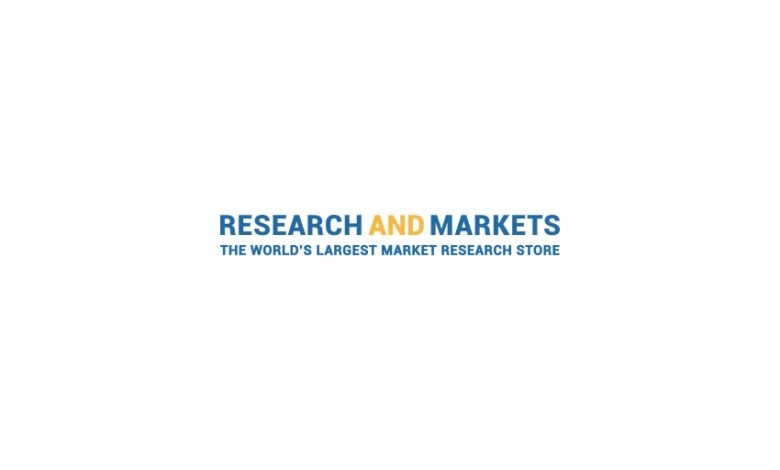
DUBLIN–(BUSINESS WIRE)–The “Global Wearable Technology in Healthcare Market: Analysis By Product, By Device Type, By Application, By Distribution Channel, By Region Size and Trends with Impact of COVID-19 and Forecast up to 2029” report has been added to ResearchAndMarkets.com’s offering.
The global wearable technology in healthcare market value in 2023 stood at US$42.6 billion, and is likely to reach US$169 billion by 2029. The global wearable technology in healthcare market value is projected to grow at a CAGR of 25.82%, during the forecast period of 2024-2029.
The wearable medical device industry exhibits high fragmentation, with numerous players contributing to a diverse landscape. The market is characterized by many companies offering a wide range of innovative devices, creating a competitive environment.
The use of wearables in healthcare has expanded significantly, with applications ranging from monitoring chronic illnesses like heart failure and diabetes to enhancing fitness tracking and health management.
One of the key drivers behind the adoption of wearable technology in healthcare is its ability to provide continuous, real-time monitoring of vital signs and other health parameters. Wearables equipped with advanced sensors can track metrics such as heart rate, blood pressure, oxygen saturation, temperature, and activity levels, enabling individuals to proactively manage their health and well-being.
Various other factors including growing prevalence of chronic diseases, increasing adoption of digital health solutions, rising healthcare costs, advancements in sensor technology and miniaturization, expanding elderly population, and rising consumer awareness and demand for personalized health and wellness solutions have also contributed to the consistent growth of global wearable technology in healthcare market.
Furthermore, the wearable technology in healthcare market is predicted to grow due to integration of AI and machine learning, focus on preventive healthcare, advances in sensor technology, remote patient monitoring and telehealth, etc.
Market Segmentation Analysis:
By Product: According to the report, the global wearable technology in healthcare market is bifurcated into two segments based on the product: diagnostic & monitoring devices and therapeutic devices.
Diagnostic & monitoring devices acquired majority of share in the market in 2023 due to their critical role in providing real-time health data, monitoring vital signs like heart rate, blood pressure, and oxygen saturation levels, and enabling early detection of health issues, which aligns with the increasing emphasis on preventive healthcare and personalized health management.
While, therapeutic device segment is the fastest growing segment due to the increasing demand for innovative solutions in pain management, rehabilitation, and insulin delivery. This growth is driven by the rising prevalence of chronic conditions, the need for non-invasive treatment options, and advancements in wearable technology like adoption of wearable robotics, such as exoskeletons and prosthetics that offer effective therapeutic interventions for various health conditions, positioning this segment for rapid expansion and adoption.
By Device Type: According to the report, the global wearable technology in healthcare market is bifurcated into three types of devices: fitness trackers and smartwatches, smart patches and others.
Fitness trackers and smartwatches acquired majority of share in the market in 2023 and is the fastest growing segment as well, due to their widespread popularity among consumers for monitoring health metrics, tracking fitness activities, and providing personalized health insights. These devices offer real-time data monitoring, integration with smartphones for quick data evaluation, and play a crucial role in promoting preventive healthcare and personalized health management, driving their dominance and rapid growth within the market.
By Application: According to the report, the global wearable technology in healthcare market is bifurcated into three applications: home healthcare, sports fitness and remote patient monitoring.
Home healthcare segment acquired majority of share in the market in 2023 due to the increasing trend towards personalized health management, convenience of monitoring health metrics at home, and the rising demand for remote health monitoring solutions, especially amidst the COVID-19 pandemic. On the other hand, the remote patient monitoring segment is expected to be the fastest growing due to its ability to provide convenient, customizable health data solutions that enable social distancing, save time, and energy, aligning with the growing importance of telehealth practices and the need for remote monitoring services.
By Distribution Channel: According to the report, the global wearable technology in healthcare market is bifurcated into three distribution channels: pharmacies, online channels, and hypermarkets.
Pharmacies segment acquired majority of share in the market in 2023 due to the increase in the number of pharmacy stores, convenience of buying while picking up medications or visiting for other healthcare needs and people’s preference for physical buying over online shopping. On the other hand, online channels are expected to witness the fastest growth because of the exponential growth of e-commerce, providing consumers with a convenient platform to explore, compare, and purchase health-centric wearables globally, enhancing market penetration and consumer engagement.
By Region: North America wearable technology in healthcare market enjoyed the highest market share in 2023 due to several factors such as a well-established healthcare infrastructure, robust research and development capabilities, a high level of technological advancements, and a strong presence of key players in the region. Additionally, factors like the increasing awareness about lifestyle management, a growing elderly population with chronic diseases, and government initiatives promoting digital health have contributed to the dominance of North America in this market.
On the other hand, Asia Pacific is expected to register the fastest growth in the wearable technology in healthcare market due to factors like the growing demand for remote patient monitoring devices, increasing adoption of advanced medical technologies, rising healthcare expenditure, and the expanding geriatric population in the region.
The rapid technological advancements and innovations in healthcare devices, coupled with the increasing prevalence of chronic diseases, are driving the growth of the wearable technology market in Asia Pacific. India is expected to be the fastest-growing region in wearable technology in healthcare. As lifestyles change and disposable incomes increase in India, the market for wearable medical devices is expected to expand significantly over the forecast period. The growth opportunity is enormous as the Indian customers are relatively younger and invest a chunk in having a healthy living.
Competitive Landscape and Recent Developments:
The key players are constantly investing in strategic initiatives, such as adoption of new technologies, introducing their services to emerging markets and more, to maintain a competitive edge in this market. For instance, recently, Garmin has launched the Lily 2 series, a stylish and health-focused smartwatch with enhanced features like sleep score tracking, dance fitness activities, and Garmin Pay contactless payments, featuring metal watch cases and concealed displays and In January 2024, Sennheiser collaborated with Polar Electro to launch the Momentum Sport earbuds that deliver high-quality sound and integrate Polar’s fitness technology, incorporating features such as a body temperature sensor and a Photoplethysmography (PPG) heart rate sensor for monitoring hydration levels during workouts.
Growth Drivers:
- Remote Patient Monitoring (RPM): The demand for RPM is rising due to factors like increasing chronic diseases and an aging population. Wearable devices enable continuous monitoring, allowing patients to stay connected with healthcare providers remotely.
- Preventive Medicine and Value-Based Care: Wearable technology supports preventive medicine by providing timely intervention and reducing hospital visits. This aligns with the healthcare industry’s shift towards value-based care models focused on patient outcomes.
- Convenience and Flexibility: Wearable devices offer convenience and flexibility for patients, enhancing their ability to manage their health outside traditional healthcare settings.
- Technological Advancements: Advancements in wearable technology, coupled with the rising penetration of smartphones and smart wearables adoption, drive market growth by improving device functionality and user experience.
- Increasing Consumer Awareness: Growing awareness about health and fitness among consumers fuels the adoption of wearable devices for health monitoring and management.
Challenges:
- Data Security and Privacy: Protecting personal health data collected by wearable devices poses significant challenges related to data security, privacy, and potential misuse of sensitive information.
- Technical Issues: Wearable devices may face technical issues such as connectivity issues, inaccurate data readings, and device malfunctions, impacting their reliability and usability.
Trends:
- Epidermal Technology: Epidermal devices worn on the skin’s surface for physiological sensing and health diagnostics are gaining traction. These non-invasive devices offer opportunities for patient monitoring and medication management, as seen with innovations like microneedle arrays for intradermal drug delivery.
- Wearable Robotics: Wearable robotics are emerging as a trend, offering assistive devices for rehabilitation and mobility support.
- Miniaturization: Trends towards miniaturization make wearable devices more discreet and comfortable for users, enhancing their adoption and usability.
- Rise of Start-ups: The increasing number of start-ups in the wearable technology space brings innovation and competition, driving advancements in device functionality and features.
- Smart Clothing: Smart clothing incorporating wearable technology sensors for health monitoring and fitness tracking is gaining popularity among consumers.
- AI-powered Medical Wearables: Integration of artificial intelligence (AI) in medical wearables enhances data analysis and insights, improving diagnostic accuracy and personalized healthcare delivery.
Key players of global wearable technology in healthcare market are:
- Medtronic
- GE Healthcare
- Abbott Laboratories
- Garmin Ltd.
- Sony Corporation
- Xiaomi Corporation
- Samsung Electronics Co., Ltd.
- Huawei Technologies Co., Ltd.
- Apple Inc.
- Omron Corporation
- Vital Connect
- NeuroMetrix, Inc.
- LifeSense Group
- Fitbit
- Motiv Ring
For more information about this report visit https://www.researchandmarkets.com/r/eiu83a
About ResearchAndMarkets.com
ResearchAndMarkets.com is the world’s leading source for international market research reports and market data. We provide you with the latest data on international and regional markets, key industries, the top companies, new products and the latest trends.
Contacts
ResearchAndMarkets.com
Laura Wood, Senior Press Manager
[email protected]
For E.S.T Office Hours Call 1-917-300-0470
For U.S./ CAN Toll Free Call 1-800-526-8630
For GMT Office Hours Call +353-1-416-8900



